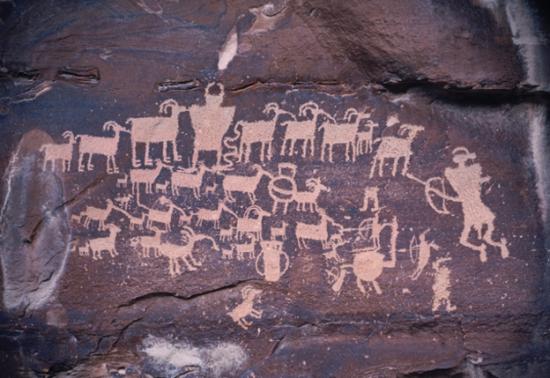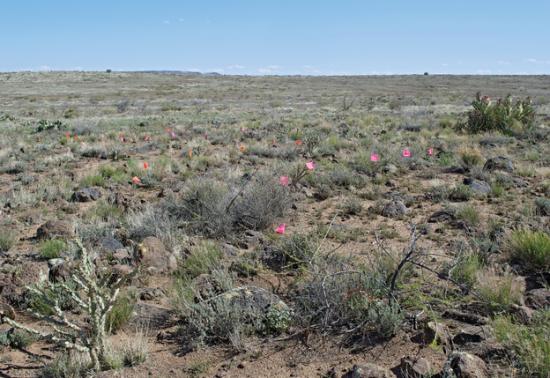
An even bigger mystery ties archaeologists in knots. Seven hundred years ago long-established prehistoric cultures started collapsing across the Southwest. The region had been booming for centuries, abetted by the spread of agriculture and complex trading networks. Then, about 1350, the Anasazi disappeared from the Four Corners region. At the same time the rugged Fremont people, dispersed in semi-subterranean pit-house villages in Utah, also vanished from the archaeological record. The chaotic upheaval extended from what’s now Salt Lake City to southern Arizona and into Mexico for another 200 years. By the 1400s the highly organized Hohokam, which had built extensive irrigation canals in the Phoenix area, collapsed, punctuating the grim span.
The debate over what happened to all of these people has been notoriously contentious for decades; researchers have pointed variously to drought, warfare, or, lately, a mass exodus to areas where the landscape could better support farming. Perry Mesa appears to have been among the best of the worst places. Recent tree-ring analysis by one of the ASU researchers, Scott Ingram, points to a wetter period in central Arizona during the 1300s, when the pueblos atop Perry Mesa expanded, supporting as many as 1,000 people. It’s possible they came out of desperation in the late 1200s but then used their ingenuity and an improving climate in the 1300s to set down roots. “I can understand why people would live there at this time, but what I don’t understand is the configuration of the houses,” he says, referring to their placement along canyon rims.
David Wilcox, an archaeologist at the Museum of Northern Arizona, in Flagstaff, hypothesizes that the settlement was “organized for war, ” with the canyon walls “being utilized like the walls of a castle.” Until ASU researchers uncovered evidence of the massive agricultural fields, Wilcox theorized that the Perry Mesa people raided farming villages in the Phoenix basin where the Hohokam were located. Next, perhaps, they got caught in a “raiding and retribution” cycle, which then required an elaborate system of defense. Now he wonders if they simply sought refuge there from the escalating warfare that seems to have spread throughout the region.
For her part, Katherine Spielmann, an archaeologist at Arizona State University, is reluctant to theorize about Perry Mesa’s architectural layout or about what caused people to first arrive and then, a hundred or so years later, pick up and leave. She contends it’s simplistic to reduce their decision making to warfare or environmental stresses when religious factors may also have been involved.
Still, one part of ASU’s focus is examining the constraints imposed by climate and determining how the Perry Mesa people overcame them—or perhaps eventually succumbed. One theory being considered is that a growing population in the 1300s atop the mesa may have exceeded the land’s carrying capacity through excessive agriculture, which could have depleted soils of their productive nutrients. There is also evidence the region was hit with another extended dry spell in the early 1400s that could have dried up their crops. What’s the point of sticking around if you can’t feed yourself and your family?

Some scientists believe that this climatic and social instability offers an instructive modern-day parallel. The Southwest is booming: Major urban hubs like Phoenix, Las Vegas, and Salt Lake City are sprawling across the desert, with strip malls and subdivisions replacing biologically rich habitat; finite water resources are being exhausted at alarming, unsustainable rates. All this explosive growth comes amid new projections from climatologists, published last year in the journal Science, that the Southwest is entering a natural cycle of high aridity and that brutally long periods of drought will be the norm all through the 21st century. Rising temperatures from global warming are expected to make things even hotter and drier.
“The drought that nearly brought this country to its knees in the 1930s wasn’t all that long,” notes Kevin Jones, Utah’s state archaeologist. Could we survive a 30-year drought the likes of which hit the Southwest around the time numerous cultures disintegrated into thin air and people started building houses and forts atop a harsh mesa top in central Arizona? “Absolutely not,” says Duncan Metcalfe, a professor of anthropology at the University of Utah. “We don’t have that kind of buffering capability built in,” he explains, referring to reservoirs and other water control technology.
What we do have going for us, though, is the scientific knowledge that enables us to be aware of such historic drought cycles and the kinds of changes we’re making to the climate today, says Julio Betancourt, a U.S. Geological Survey paleoecologist based in Tucson. “It is almost certain that pre-modern societies lacked sufficient understanding of their physical and biological environment to escape natural disasters or avoid many land-use impacts,” he points out.
Today, for example, scientists can pinpoint wet and dry periods going back thousands of years just by examining tree rings. This detailed reconstruction of the historical environment would seem to be an invaluable resource to planners and policy-makers alike. “Yet tree-ring science is not utilized by water planners,” says Betancourt, who adds: “We invest considerable sums of money and effort in investigating nature and how it works, but all this information is underutilized.”
Whatever happened to the Anasazi at Mesa Verde or the people of Perry Mesa may never be solved, but the landscapes they left behind stand as haunting testaments to the turbulent time in which they lived. “It’s almost cliché to say that if you don’t understand history, you’re going to repeat some real mistakes you don’t want to,” says Metcalfe. “The fact is, when we include prehistory in North America, it gives us that much more to be mindful of.”